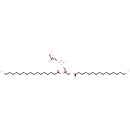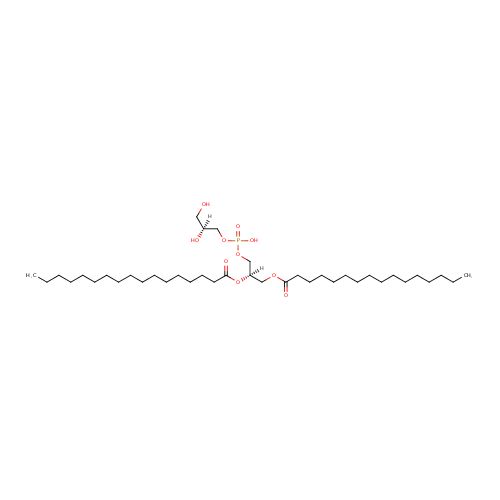|
Record Information |
|---|
| Version |
1.0 |
|---|
| Update Date |
1/22/2018 11:54:54 AM |
|---|
|
Metabolite ID | PAMDB001465 |
|---|
|
Identification |
|---|
| Name: |
PG(17:0/16:0) |
|---|
| Description: | PG(17:0/16:0) is a phosphatidylglycerol. Phosphatidylglycerols consist of a glycerol 3-phosphate backbone esterified to either saturated or unsaturated fatty acids on carbons 1 and 2. As is the case with diacylglycerols, phosphatidylglycerols can have many different combinations of fatty acids of varying lengths and saturation attached to the C-1 and C-2 positions. PG(17:0/16:0), in particular, consists of one heptadecanoyl chain to the C-1 atom, and one hexadecanoyl to the C-2 atom. In Pseudomonas aeruginosa glycerophospholipid metabolism, phosphatidylglycerol is formed from phosphatidic acid (1,2-diacyl-sn-glycerol 3-phosphate) by a sequence of enzymatic reactions that proceeds via two intermediates, cytidine diphosphate diacylglycerol (CDP-diacylglycerol) and phosphatidylglycerophosphate (PGP, a phosphorylated phosphatidylglycerol). Phosphatidylglycerols, along with CDP-diacylglycerol, also serve as precursor molecules for the synthesis of cardiolipin, a phospholipid found in membranes. |
|---|
|
Structure |
|
|---|
| Synonyms: | - 1-heptadecanoyl-2-hexadecanoyl-glycero-3-phospho-(1'-sn-glycerol)
- 1-heptadecanoyl-2-palmitoyl-sn-glycero-3-phosphoglycerol
- 1-margaroyl-2-hexadecanoyl-sn-glycero-3-phospho-(1'-glycerol)
- 1-margaroyl-2-hexadecanoyl-sn-glycero-3-phosphoglycerol
- GPG(17:0/16:0)
- GPG(33:0)
- PG(33:0)
- Phosphatidylglycerol(17:0/16:0)
- Phosphatidylglycerol(33:0)
|
|---|
|
Chemical Formula: |
C39H77O10P |
|---|
| Average Molecular Weight: |
736.9964 |
|---|
| Monoisotopic Molecular
Weight: |
736.525435196 |
|---|
| InChI Key: |
MXWSMQMRZPPNRI-PQQNNWGCSA-N |
|---|
| InChI: | InChI=1S/C39H77O10P/c1-3-5-7-9-11-13-15-17-19-21-23-25-27-29-31-39(43)49-37(35-48-50(44,45)47-33-36(41)32-40)34-46-38(42)30-28-26-24-22-20-18-16-14-12-10-8-6-4-2/h36-37,40-41H,3-35H2,1-2H3,(H,44,45)/t36-,37+/m0/s1 |
|---|
| CAS
number: |
Not Available |
|---|
| IUPAC Name: | [(2S)-2,3-dihydroxypropoxy][(2R)-2-(heptadecanoyloxy)-3-(hexadecanoyloxy)propoxy]phosphinic acid |
|---|
|
Traditional IUPAC Name: |
(2S)-2,3-dihydroxypropoxy(2R)-2-(heptadecanoyloxy)-3-(hexadecanoyloxy)propoxyphosphinic acid |
|---|
| SMILES: | [H][C@](O)(CO)COP(O)(=O)OC[C@@]([H])(COC(=O)CCCCCCCCCCCCCCC)OC(=O)CCCCCCCCCCCCCCCC |
|---|
|
Chemical Taxonomy |
|---|
|
Taxonomy Description | This compound belongs to the class of organic compounds known as phosphatidylglycerols. These are glycerophosphoglycerols in which two fatty acids are bonded to the 1-glycerol moiety through ester linkages. |
|---|
|
Kingdom |
Organic compounds |
|---|
| Super Class | Lipids and lipid-like molecules |
|---|
|
Class |
Glycerophospholipids |
|---|
| Sub Class | Glycerophosphoglycerols |
|---|
|
Direct Parent |
Phosphatidylglycerols |
|---|
| Alternative Parents |
|
|---|
| Substituents |
- 1,2-diacylglycerophosphoglycerol
- Dialkyl phosphate
- Fatty acid ester
- Fatty acyl
- Alkyl phosphate
- Phosphoric acid ester
- Organic phosphoric acid derivative
- Organic phosphate
- Dicarboxylic acid or derivatives
- Saccharide
- Secondary alcohol
- Carboxylic acid ester
- 1,2-diol
- Carboxylic acid derivative
- Hydrocarbon derivative
- Primary alcohol
- Organooxygen compound
- Carbonyl group
- Alcohol
- Aliphatic acyclic compound
|
|---|
| Molecular Framework |
Aliphatic acyclic compounds |
|---|
| External Descriptors |
|
|---|
|
Physical Properties |
|---|
| State: |
Not Available |
|---|
| Charge: | -1 |
|---|
|
Melting point: |
Not Available |
|---|
| Experimental Properties: |
|
|---|
| Predicted Properties |
|
|---|
|
Biological Properties |
|---|
| Cellular Locations: |
Membrane |
|---|
| Reactions: | |
|---|
|
Pathways: |
|
|---|
|
Spectra |
|---|
| Spectra: |
|
|---|
|
References |
|---|
| References: |
- Kanehisa, M., Goto, S., Sato, Y., Furumichi, M., Tanabe, M. (2012). "KEGG for integration and interpretation of large-scale molecular data sets." Nucleic Acids Res 40:D109-D114. Pubmed: 22080510
- Keseler, I. M., Collado-Vides, J., Santos-Zavaleta, A., Peralta-Gil, M., Gama-Castro, S., Muniz-Rascado, L., Bonavides-Martinez, C., Paley, S., Krummenacker, M., Altman, T., Kaipa, P., Spaulding, A., Pacheco, J., Latendresse, M., Fulcher, C., Sarker, M., Shearer, A. G., Mackie, A., Paulsen, I., Gunsalus, R. P., Karp, P. D. (2011). "EcoCyc: a comprehensive database of Escherichia coli biology." Nucleic Acids Res 39:D583-D590. Pubmed: 21097882
- Uniprot Consortium (2012). "Reorganizing the protein space at the Universal Protein Resource (UniProt)." Nucleic Acids Res 40:D71-D75. Pubmed: 22102590
- Yurtsever D. (2007). Fatty acid methyl ester profiling of Enterococcus and Esherichia coli for microbial source tracking. M.sc. Thesis. Villanova University: U.S.A
|
|---|
| Synthesis Reference: |
Not Available |
|---|
| Material Safety Data Sheet (MSDS) |
Not Available |
|---|
|
Links |
|---|
| External Links: |
| Resource | Link |
|---|
| CHEBI ID | Not Available | | HMDB ID | Not Available | | Pubchem Compound ID | 52927173 | | Kegg ID | Not Available | | ChemSpider ID | Not Available | | Wikipedia ID | Not Available | | BioCyc ID | Not Available |
|
|---|


